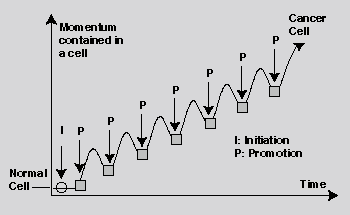2. Momentum Contained in A Cell
"A cancer cell contains a large amount of momentum compared with a normal cell." This indication can be deduced from theoretically analyzing two-stage carcinogenesis.
Two-stage carcinogenesis causes cancer through two steps. The first step is "Initiation," which indicates a step that a tissue or a cell is treated with a chemical substance named "Initiator." The second step is "Promotion," which indicates a step that a tissue already treated with an initiator is also treated with an another chemical substance named "Promoter.
Importantly, a tissue or a cell treated with a promoter can be considered to raise the momentum. A promoter is a chemical substance that has the ability of causing inflammation. Additionally, a tissue with acute inflammation usually swells, and can be considered to increase the momentum. Thus, it is concluded that when a tissue or a cell is treated with a promoter, it raises the momentum.
This indication allows us to deduce the difference in momentum between a normal and a cancer cell. Every time cells already treated with an initiator are also treated with a promoter, they increase the momenta. After that, they transform themselves into cancer cells. These reasons enable us to indicate that a cancer cell contains a large amount of momentum compared with a normal cell. The figures below illustrate these mechanisms.

|